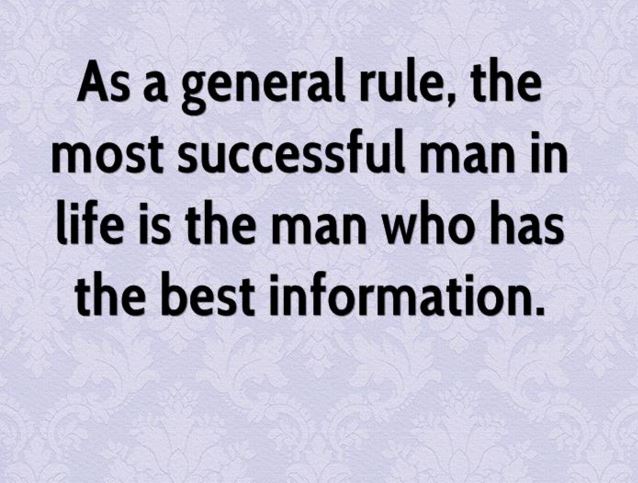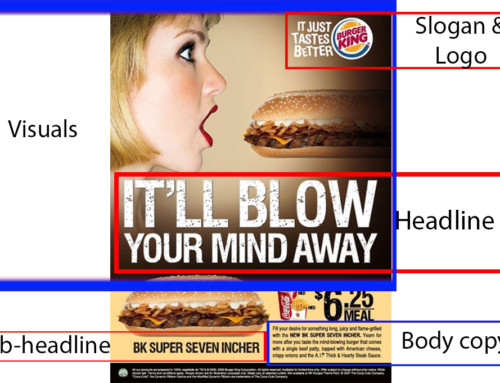Hey guys! How are you finding the series thus far? I hope it has been good. I hope that you managed to respond to the questionnaire when we talked about the Marketing Control System and that as a result you have a good idea of how effective (or not) your marketing strategy will be in 2016. Moving on, Benjamin Disraeli said, ‘As a general rule, the most successful man in life is the man who has the best information.’ This quote also applies to business. Those who know the most about their markets, their customers and their environment will be better than their competition. This is because they will be able to make the best business decisions, and good decisions will make you much more money. We are going to look at how a marketing information system can help you make great business decisions.
In the last article we talked about the Marketing Control System. Now, what’s control when you do not have good information at hand?
A marketing information system is a management information system designed to support marketing decision making. Jobber (2007) defines it as a system in which marketing data is formally gathered, stored, analysed and distributed to managers in accordance with their informational needs on a regular basis. In this article we are going to touch only on aspects that we can use in Zimbabwe. This is in line with the current situation that we are in when it comes to resources.
The Marketing Information System (Kayku-City). We will discuss the aspects that can be easily be implemented in Zimbabwe. Want to know about the other aspects? We can discuss them in the comments section below.
How to Establish the Marketing Information System Needs
I am sure that most of you have gone to the doctor before. As a child I used to dread that trip, the injections eish! I used to feel the injection poking my bone even when I was still at home before the appointment. Do any of you remember that feeling? I also used to get irritated by the scent (smell rather) of the doctor’s chambers. The scent used to make me feel like a lab rat. What bored me even more were the doctor’s questions. Some of the questions went like this:
- What brings you in today?
- What hurts?
- What are your symptoms?
Let us play doctor to our internal marketing patients, shall we?
The questions were for my own good though. Obviously the doctor had to know what was wrong before he could fix you up. That’s called a diagnosis. We also diagnose when we are creating a marketing information system, so let’s play doctor. This line of questioning is one of the main tools that are used in creating a marketing information system. The questions will lead to the creation of a prescription i.e. the components of the marketing information system. Let us sample some of the questions below:
- What decisions do you regularly make?
Let’s say that your manager states that he needs to make a decision on the objectives for his 2016 marketing strategy. We will need to ensure that our marketing information system contains tools that conduct SWOT analyses. Why? Because knowing a firm’s strengths, weaknesses, opportunities and threats will will enable us to take advantage of the firm’s strengths and weaknesses whilst minimising or eliminating the weaknesses and threats.
The fact that he needs to decide on objectives means that these objectives need to be SMART (Specific; Measurable; Attainable; Realistic; Timed). Our marketing information system consequently has to contain elements that will enable the manager to make SMART decisions. For example, if the objective is to increase market share by 5% the system has to have an element of research e.g. forecasting potential demand on potential customers to assess the likelihood of them switching to us. The results will ensure that the manager will make a realistic decision which is the ‘R’ in SMART.
Oracle Enterprise Resource Planning. Systems like these usually have, depending on your requirements, information on sales performance. The information is useful, but it is usually not enough. When you are designing a marketing information system you have to atone for shortfalls such as these.
2. What information do you need to make these decisions?
Below are a few examples of the type of information that marketers need:
- Sales
- Costs/Expenses
- Profits
Now, the issue here is that this type of information, when sitting on platforms like Oracle, is usually available at a macro level. You will get the numbers but not the stuff that dwells in between the lines. Marketing managers also want to know the following:
- Feedback on the marketing strategy
- Customer complaints
- Compliments
- New product ideas
- Information on the competition
- Changes in the marketplace
Looking at those needs you will know, for example, that your marketing information system has to include customer satisfaction surveys that will be carried out periodically in order to get information such as complaints and compliments.
3. What information do you regularly get?
Sounds straight forward right? Well it’s not. In order to know the type of information that your marketing managers get you will have to conduct an information audit. This is critical as you cannot rely on someone remembering all the information that they receive thus the use of this structured approach. An information audit is an analysis and evaluation of a firm’s information system (whether manual or computerised) to detect and rectify blockages, duplication and leakage of information. The objectives of this audit are to improve accuracy, relevance, security and timeliness of the recorded information (Business Dictionary). By the time you finish conducting the audit you will have answered the question above.
So now we know that our marketing information system needs an information audit. Basically this exercise involves interviewing the marketing people asking questions like:
- Rank and identify your three most vital sources of information and the three most disposable sources of information, and explain why
- Disregard all the actual sources that you work with now. Imagine your ideal information source and how you would use it
- Recollect and describe – two or three recent incidents where you received important information from a non-routine source and you acted on the information
As you can see these questions are about diagnosis and prescription adding the right tactics and tools along the way to ensure that you have a complete system at the end of it all.
In order to establish what your marketers need in terms of marketing information you need to ask them 10 questions. The other 7 questions are:
4. What special studies do you periodically request?
5. What information would you want that you are not getting now?
6. What information would you want daily? Weekly? Monthly? Yearly?
7. What magazines and trade reports would you like to see on a regular basis?
8. What topics would you like to be kept informed on?
9. What data analysis programs would you want?
10. What are the four most helpful improvements that could be made in the present marketing information system?
By the time you get to question number 10 you will know how your marketing information system should be structured and the tools/components that will be required to make it efficient.
Now, back to that diagram with the marketing information system. We are going to look at the first two components, Internal Records and Marketing Intelligence. We will touch on the other two in future articles. The purpose of us analysing these components is for us to spot opportunities that can improve our marketing.
Internal Records
The marketing information system should look at internal reports on orders, sales etc. with an analytical eye with the aim of unearthing opportunities and threats and providing the marketing managers with this information. We will use the Order to Payment Cycle as an example of how this analysis can be done. Other internal records include the Sales Information Systems and the Customer Databases.
The Order to Payment Cycle. A function of the Marketing Information System is to spot opportunities for improvement along the cycle and make the information available to the marketing managers
An Order to Payment Cycle is a system which records the timing and size of orders placed by the customers, the payment cycle followed by consumers and the time taken to fulfill the orders in the shortest possible time. Customers place orders through the sales people and companies dispatch the goods and receive payment directly through the bank. A proper record system pertaining to order to payment cycle management helps managers to decide on production and dispatch schedules, inventory and accounts receivable schedule and also logistics and distribution management schedules. (Invensis)
So, how do you spot opportunities for improving your marketing from this cycle? You do so by analysing various elements across the cycle, like in the examples below:
Question 1
Does the company issue credit memos that are more than 1% of total sales? – This question relates to the ‘Invoicing’ part of the cycle.
A credit memo is a contraction of the term ‘credit memorandum’, which is a document issued by the sellers of goods or services to the buyer, reducing the amount that the buyer owes to the seller under the terms of an earlier invoice (Accounting Tools).
You notice that Betty has been sending the wrong invoices quite a lot of times and you continuously have to issue credit memos so as to correct her mistakes. The following are the possible repercussions of such forms of conduct:
- An increase in the level of customer dissatisfaction. This could reduce the level of sales
- More in depth audits by internal and external auditors to find out why such patterns are occurring. This would affect sales/service as people will now be busy assisting the auditors instead of sending out invoices to customers
Through the marketing information system you realise that thanks to Betty we are issuing credit memos at the rate of 7% of total sales. This information is sent to the marketing manager who then:
- Communicates with the Billing Manager to ensure that he pays more attention to this issue in order to reduce the amount of credit memos issued to 1% of total sales
- Proposes that a billing system is installed which will automate the billing process in a way that will reduce errors. This of course will be done after conducting a cost benefit analysis
After this has been done a threat in the cycle will have been nullified. A threat which would have affected the results that the marketing department would have been able to produce.
Question 2
Do you have more than two weeks of raw material inventory? – This talks to the ‘Order Fulfillment’ section of the cycle
The two weeks part of it is just an example. The issue here is that when you are holding inventory you will be incurring warehousing costs. Even if it’s your warehouse you will be losing the potential income that you would have gotten for someone maybe parking their car in that space.
The Pareto Principle. Analyse your operations to ensure that you are not using your resources in ways that are not efficient
So, your marketing information system has helped you to realise that you are holding too much inventory. You then realise that there is an opportunity to Pareto your inventory. What is to Pareto by the way? It is a principle, named after economist Vilfredo Pareto, that specifies an unequal relationship between inputs and outputs. The principle states that for many phenomena, 20% of invested input is responsible for 80% of results obtained. Put another way, 80% of consequences stem from 20% of the causes. Also referred to as the ‘Pareto Rule’ or the ’80/20 Rule.’
So, gather sales and inventory together by item. Construct 2 Pareto charts. For the first chart, classify your items into A, B, C and D (80%, 15%, 5%, 0%) based on sales. Then calculate your inventory for each group. Do your A items represent 50% of your inventory? If not you may not have enough inventory for those items. A significant amount of inventory on low value items may indicate problems with product run outs, transitions, engineering change management, and managing obsolete inventory.
For the second chart, classify your items based on inventory. Then calculate the sales for each group. Again, do your A inventory items represent at least 50% of your sales? If not, inventory may be out of balance. After gathering this information you have the makings of a supply chain data warehouse for further analysis.
You will then be able to realign your stocks with the sales and product demand. The result will be a warehouse that does not carry a lot of inventory for too long as for example, you will keep less inventory for slow moving products saving money. Orders will also be fulfilled in time as inventory will now be aligned with demand and the result will again be more money.
The Marketing Intelligence System
Market intelligence is the information relevant to the company’s markets, gathered and analysed specifically for the purpose of accurate and confident decision-making in determining strategy in areas such as market opportunity, market penetration strategy, and market development (Wikipedia).
The marketing information system is responsible for this aspect. It has to ensure that the marketers know what is going on in the business environment at all times. Take a look at the example below which relates to question number 4 on the 10 questions that we talked about earlier in this article.
Environmental Reports
You can use the marketing information system to source and provide marketing intelligence reports such as these for your marketing managers.
So, your marketing manager is looking to recruit some graduate trainees. The marketing information system can help with information such as the one in the chart above. Let me quote a passage from the report that talks to the image above:
Labour Market Risk (36.90/100) – Zimbabwe’s labour market cannot compete with its regional peers owing to low levels of productivity, public health issues and the residual effects from the economic collapse and hyperinflation during the mid-2000s. Although Zimbabwe has a favourable demographic situation, with more than 60% of the population younger than 24, the country continues to struggle to turn its population into skilled workers, and we see no signs of that situation improving over the medium term.
According to the scale in the image above the marketing manager will now know that he faces the possibility of hiring trainees who might fail to get the job done as Zimbabwe is said to be failing to turn its people into skilled workers. In that case the report is questioning the quality of the youths that we produce, among other things. So if he or she is keen on recruiting locally he or she can engage the Human Resources department to ensure that training and career development programs are in place to cover this gap. He can ensure that the trainees are signed up to medical aid programs to deal with the issue of the public health system. If all of this does not seem to be feasible, and the company is attractive enough, he or she can always take the route of bringing in trainees from neighbouring countries that have said to be better than us in terms of their quality as employees is concerned. When a good marketing information system is put in place any decision can be made based on proven facts and figures and not opinions, common sense, or gut feeling.
So there it is folks! That was an insight into how a marketing information system can be created and how it can be made to work. We started with the 10 questions that you can ask your marketing managers so that you can establish what type of information that they need, the tools and the methods that will be required to attain that information. We also looked at two tenets of the marketing information system namely internal records and the marketing intelligence system and demonstrated how these two can be used to provide useful information that can be used by marketers. What do you think about the system? Will it help you to make better marketing decisions than your competitors thus giving you a competitive advantage? Let us here your thoughts in the comments section below.
Thanks
Ruvimbo








Awesome, all entrepreneurs looking at profitable enterprise need this. Being one of them; thank you Ruvimbo. Thumps UP !
Hi, thank you very much for the compliment Simba. We can make it as entrepreneurs, right here in Africa!
What’s up, I want to subscribe for this website to get latest updates, therefore where can i do it please help.
Hello Сialis you can do that on the orange bar at the top of the screen thank you.